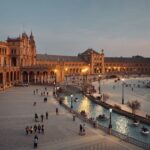Athens City Breaks : Perfect city for a short break
Introduction
Athens City Breaks : Welcome to Athens a place where ancient monuments stand beside hipster coffee joints and rooftop bars. Longing for one last blast of warmth before winter sets in? Look no further than Athens. Ancient history is Europe’s tourism trump card, so why is it that the most ancient city on the Continent has been so overlooked? Compared to the likes of Paris, Rome and Barcelona, Athens has paled in popularity, until now. It is fast-becoming the destination of choice for a wave of savvy millennial travelers looking for a sun-drenched city break with a difference. If you dare to see beyond Greece’s economically turbulent time, you will be rewarded endlessly.
Did you buy your flight ticket? Compare and buy the cheapest one
What to eat & drink in Athens
Let’s start first of all to nourish our stomach before our eyes. Make sure you try bougatsa, a kind of filo pastry with custard filling, dusted with sugar and cinnamon. Join the queue along with the rest of Athens at Bougatsa Thessaloniki on Iroön square.

Or, pick up a koulouri. Sold on every street corner for around a euro, the bread rings covered in sesame seeds are crunchy on the outside, soft and chewy on the inside and make an ideal breakfast or on-the-go snack. For a taste of Athenian street food, Epirus, tucked away inside the Central Meat Market is one of the last oinomageireia left standing in the capital (family restaurants offering home-brewed wine and food), where the dishes are laid out in the kitchen for you to choose. The long association with the Ottoman Empire has resulted in a Turkish-inspired cuisine called politiki (associated with Istanbul) and smyrneïki (from Smyrna). One of the best places to taste its dishes is Pera on Aiolou street – you’ll smell the aromatic spicy food long before you enter. Finally, if you want a twist on traditional Greek cooking with international aspirations, nab a table at the Michelin-starred Hytra at the Onassis Cultural Centre on Syngrou Avenue. Read more on Fine Dining in Athens
What to do in Athens City Breaks?
Explore the Athens cocktail scene
Factor in time to scour the streets of Psyrri, a neighbourhood around Iroön square where numerous relaxed bars offer unique signature cocktails. Clumsies on Praxitelous St or Baba Au Rhum on Klitiou are regularly voted among the best bars in the world with avant-garde mixologists whipping up creative concoctions. ‘Baba’, as it’s affectionately called, with more than 100 kinds of rum, is a game-changing bar that started a mixology craze transforming the capital’s cocktail scene into one of the most riveting in Europe. Athens City Breaks
Explore Monastiraki flea market
Monastiraki was the grain market in Ottoman times and on a cursory look, nothing has changed. The commotion brings to mind street scenes straight out of Damascus or Cairo: shopkeepers tout loudly for business, clients haggle and crowds meander the stalls aimlessly. The bargains you’ll find here range from leather goods and jewellery, to army surplus garb, antiques, shoes, suitcases and ceramics.

Take a stroll along the ‘Grand Promenade’
Take the pedestrianised path below the Acropolis past the Herod Atticus Roman theatre, around Filopappou Hill and the 12th-century church of Agios Georgios Loumbardiaris to the stony mound of Pnyka. Democracy was born here 25 centuries ago, as Athenian citizens sat down to hear orators speak and to vote on public matters. Continue through the old Roman and Ottoman centres and finish at Thission station where the nearby Temple of Hephaestus is arguably one of the best-preserved classical monuments in Greece. Athens City Breaks
The Rooftop Bars
Scattered throughout the city, the rooftop bars of Athens are hard to find. Often hidden away and terribly signposted, each one feels like a secret society for people in-the-know. They’re buzzing morning, noon and night and depending on what time you go you’ll get a different perspective of the Acropolis and the white washed city below. Head to Couleur Locale for the ultimate secret scene or go to The Roof Garden at The Electra Metropolis to watch an incredibly chic sunset.

The Coffee Culture
Coffee culture is rife in Athens. Young creatives and business minds flock to the most on-trend establishments in the city such as Tailormade, Spollati or Six d.o.g.s, where outdoor tables are hot property. If you’re lucky enough to get one, pull up a pew, order yourself a ‘freddo’ coffee and prepare to watch the catwalk of passersby.

Our Hotel Selection in Athens
Athens City Breaks: If you want to be right in the throbbing centre of modern Athens with all its pros (proximity to everything) and cons (noise), look no further than Athens Mansion Luxury Suites located in a listed building with an oasis of a roof terrace to chill out in. Condo hotels featuring large spaces and state-of-the-art facilities are a recent trend in the capital and Thission Luxury Homes is the latest arrival, with seven spacious apartments that are ideal for families. If you prefer somewhere cosy, snuggle up at Home & Poetry, a neoclassical stylish hotel in Plaka whose terrace bar delivers a close view of the Acropolis night illuminations. For a sleek look, check-in at the contemporary Athens Tiare Hotel in Omonia with extra business touches like free smartphones in every room, laptop rental and VIP airport and ferry transfers. If you want to flash the cash, Marriotts’ Grande Bretagne, abode of politicians, kings and rock stars on Syntagma square, is hard to beat, although Andronis Athens, a comfortable boutique hotel near Monastiraki with an excellent in-house café-restaurant comes close. Check out our Athens Riviera propositions.
Explore Athens City
Continuously inhabited for over 7,000 years, Athens is one of the oldest capitals in the world and is often referred to as the cradle of Western civilisation and democracy. Today the Greek capital is a vast, modern city with a cornucopia of things to see and do. Explore antiquity up close, immerse yourself the culture and life of the city and feast on delicious food.
Best time for a short break in Athens city? Spring and Autumn… Summer lingers in Athens , which basks in a glow of 68F (20C) as October slips into November. A wide range of flights also make it a feasible destination.
Acropolis
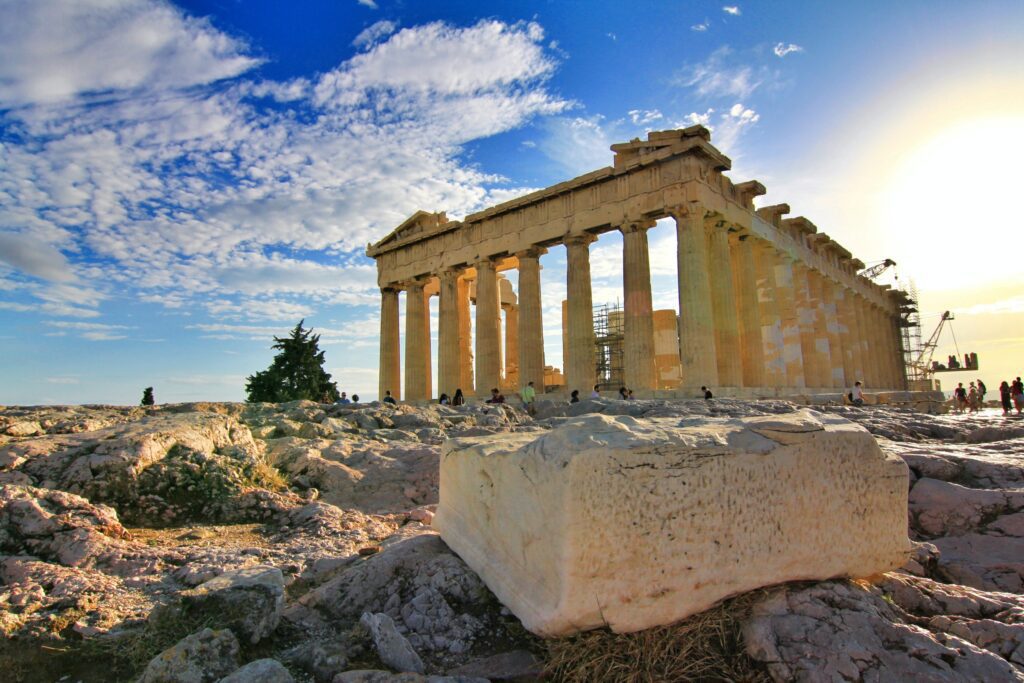
There’s nothing we can tell you that hasn’t been said many times about Athens’ ancient citadel. The Acropolis is on an abrupt rocky outcrop above the city and has world-renowned Classical landmarks that people spend whole lifetimes waiting to see in the flesh. The pinnacle of these is of course the Parthenon, but The Propylea, the Erectheion and the Temple of Athena Nike are indispensible, and you can skip the queues and get enthralling inside facts and titbits about ancient Greek democracy and philosophy with a registered guide. The going is steep and slippery on timeworn marble, until you reach the flat summit, and be prepared for cranes and scaffolding, which are an understandable necessity for a World Heritage Site.
Parthenon
Athens City Breaks: Seen as the greatest achievement of the Doric Order and Classical Greece’s most significant building to make it to the 21st Century, the Parthenon is a symbol of western civilisation and Athenian democracy. The Parthenon was dedicated to the goddess Athena and begun in 447 BC, when the Athenian Empire was the dominant force in the Aegean.Co-designed, by Ictinus and Callicrates, at that time it was a city treasury before becoming a church in the 6th century and then a mosque in the 1460s. Notoriously, some of the Parthenon’s sculptures were plundered by The Earl of Elgin at the start of the 18th century and were later sold to the British Museum where they remain. The remainder of the original frieze and pediment sculpture is the highlight of the Acropolis Museum.
Acropolis Museum
The work of Swiss architect Bernard Tschumi, the Acropolis Museum in on the southeast slope and was unveiled in 2009 to present the many thousands of artefacts discovered on the archaeological site of the Acropolis. Smartly oriented to give you constant views of the Parthenon, the museum is built over ancient ruins and much of the ground floor has glass panels and open spaces, showing the foundations below. On three levels visitors are sent on a chronological trip through the centuries, starting with the hill’s archaic discoveries in a large trapezoidal hall that also has findings from the Erechtheion, the Propylaea gateway and the Temple of Athena Nike. After this you go up to wonder at the marbles from the frieze (including metopes) and the pediments of the Parthenon in a hall with the same dimensions, column spacing and orientation as the temple.

Erechtheion
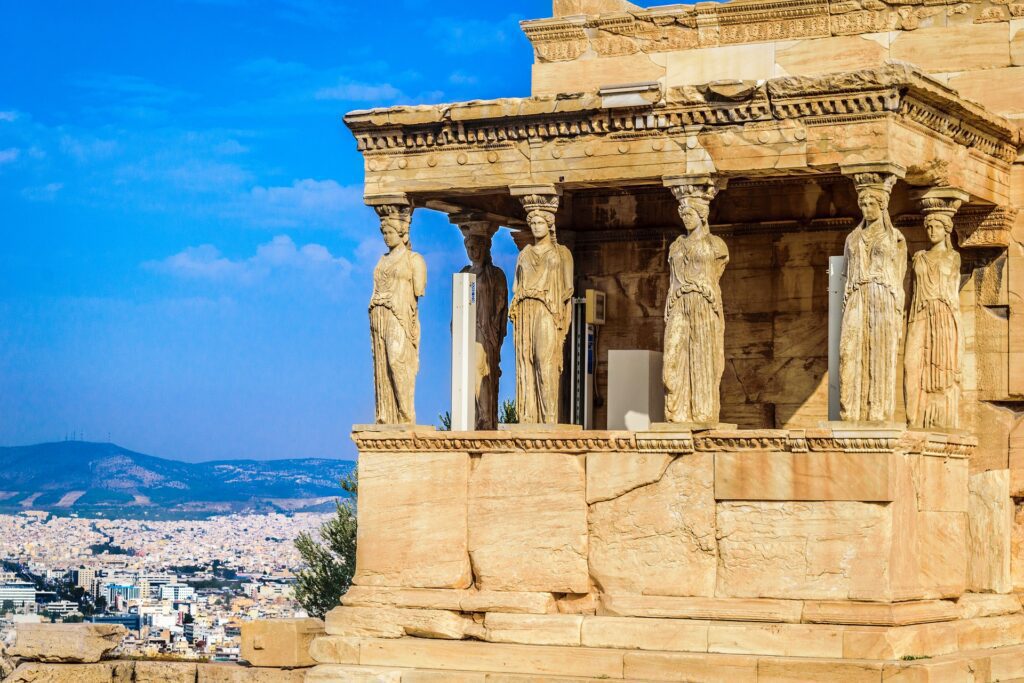
On the north side of the Acropolis is a temple to Athena and Poseidon, built in the Ionic Order from 421 to 406 BC. After antiquity this monument had all sorts of uses, as a Byzantine church, a palace in the Frankish period and much later a residence for the Ottoman commander’s harem. The thing you have to see, and the Erechtheion’s defining image, is the southern Porch of the Maidens. This has six magnificent caryatids supporting its roof, carved by Callimachus or Alcamenes. The current caryatids are casts, and five of the originals are now in the Acropolis museum and a sixth is at the British Museum.
National Archaeological Museum
A veritable wonderland of ancient art, it’s fitting that Athens’ National Archaeological Museum should be one of the largest and richest in the world. The galleries are jammed with star exhibits that have been beguiling scholars for generations. Take the finds from the Atikythera wreck, identified in 1900 and dating back to the 4th century BC. This yielded the Atikythera Mechanism, the world’s oldest analogue computer and the contemplative Philosopher’s Head. Then there’s the Mask of Agamemnon, a gold funerary mask from the 16th century BC , most likely made for Mycenaean royalty, though too early for Agamemnon. See also the Eleusinian relief from the 5th century BC, as well as Bronze Age frescoes from the islands of Santorini and Thera and the Jockey of Artemision, a beguiling statue of a racehorse from 150-140 BC.
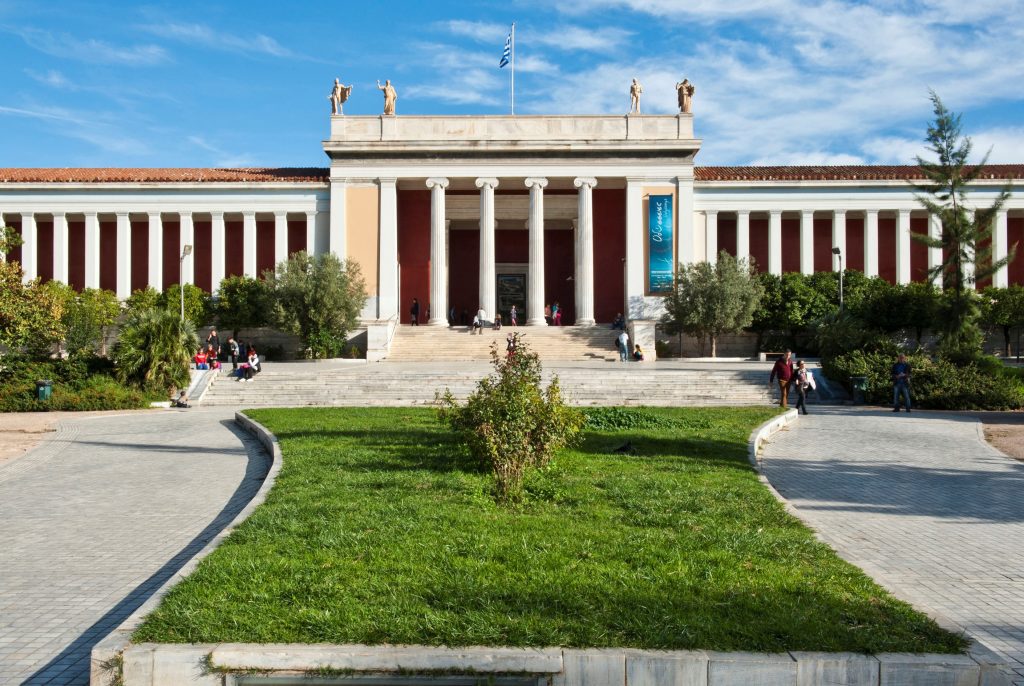
Temple of Hephaestus
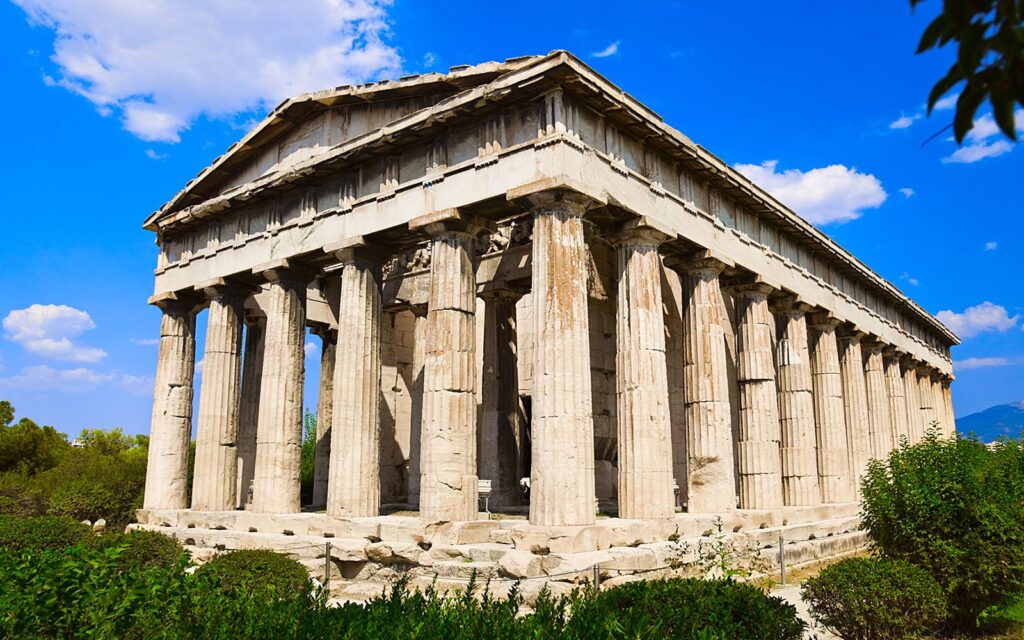
Atop the 65-metre Agoraios Kolonos hill on the northwest side of the Agora of Athens, the Temple of Hephaestus is a Doric peripteral temple in an amazing state of preservation. It was built in the second half of the 5th century BC and construction was delayed for three decades because funds and labour were redirected towards the Parthenon. Designed by Ictinus, the temple was dedicated to Athena and Hephaestus who was the ancient god of fire, metalworking, forges, sculpture and stonemasonry, and has six fluted columns on its west side and 13 on its north and south. You can also make out plenty of sculpted elements, from the Labour of Hercules on the meotopes on the east side, to the pronaos and opisthodomos, which show Theseus with the Pallantides and the battle of Centaurs and Lapiths.
Museum of Cycladic Art
Beginning in the 1960s the couple Nicholas and Dolly Goulandris amassed the world’s largest collection of prehistoric art from the Cycladic Islands in the Aegean. By the 1980s this was enough to fill a museum, which opened in 1986. There are more than 3,000 pieces of Cycladic, Ancient Greek and Cypriot art at the museum, dating from 3,000 to the 4th century BC. But it’s the Cycladic marble figurines that draw the most acclaim. If you love modern art you may notice uncanny similarities between their minimal, abstract lines and works by the likes of Giacometti and Henry Moore.
Temple of Athena Nike

In a commanding position, raised on a bastion on the southeast slope of the Acropolis, the Temple of Athena Nike is from 420 BC and was the first complete Ionic Order temple on the hill. It’s the most recent of a number of temples dedicated to Athena Nike at the Acropolis, the previous of which was destroyed by the Persians in 480 BC. Conceived by Callicrates, this edifice is a tetrastyle Ionic temple with four elegantly narrow columns on its front and rear porticos that have the hallmark Ionic volutes or scrolls. Fragments of the frieze and relief around the parapet below are on display at the Acropolis Museum, including the sublime wet drapery sculpture of the goddess fixing her sandal.
Plaka
An antidote to both the silent ancient temples and traffic-heavy modern city, Plaka lies on top of ancient Athens’s residential quarters in the shadow of the Acropolis. It’s a district of tight, twisting alleys with 19th-century facades garlanded with flowering bougainvillea in summer. Plaka is jam-packed with family-run shops, each with something alluring, from ceramics, musical instruments, handmade jewellery to specialty food shops stacked high with olives and spices. And whether you want to pick up a gyro or sit down to a meze Plaka is a go-to for dining and nightlife. Below the rocky notheastern slope of the Acropolis is Anafiotika, a steep whitewashed neighborhood settled in the 19th-century reign of Otto of Greece when workers moved here during the renovation of King Othon’s Palace.

Temple of Olympian Zeus

Now, not much of this temple east of the Acropolis has been left standing, but what remains is more than enough to tell you that it used to be vast. The Temple of Olympian Zeus had an extremely long construction period, started in the 6th century BC but not completed until the rule of Emperor Hadrian in the 2nd Century AD. In that time the prevalent order had switched to Corinthian, and the 15 surviving columns of an original 104 have scrolls and acanthus patterns. The temple was pulled down during the Herulian sack of Athens in 267, little more than a century after it was completed , and its stone was quarried for other buildings around the city.
Benaki Museum

A near-complete chronology of Greek history and culture, the Benaki Museum was founded by the art collector Antonis Benakis in 1930. He set up the institution in memory of his father Emmanuel who had died the year before and was a prominent politician. On three floors you can follow the course of Greek art from prehistoric times to the present. The ground floor has surprisingly sophisticated Neolithic vases, as well as Archaic ceramics and figurines and Classical sculpture. The first floor leads you through the late Byzantine period and Ottoman rule, and is endowed with religious icons and examples of folk costume. Then after the cafeteria on the 3rd, the top floor has paintings, documents and weapons from the Greek War of Independence against the Ottoman Empire from 1821 to 1829.
Ancient Agora of Athens
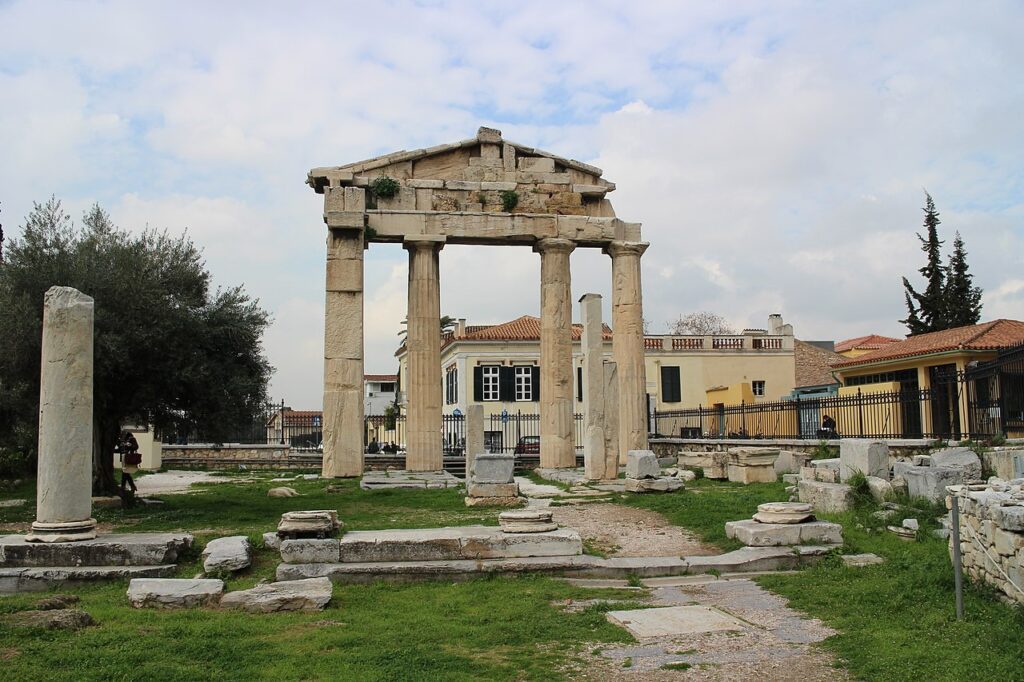
Reserved for trade and public gatherings, the Agora was the centre of Classical Athens and is cushioned by the Acropolis to the southeast and the Agoraios Kolonos hill to the south. It was drawn up in the 6th century BC and is a wide-ranging site with the ruins of more than 30 buildings and monuments. Download a map, go slow and let you imagination wander. Or hire a guide who will explain the ancient customs that once took place where you stand, like ostracism, in which potential threats to the state were preemptively forced into exile.
Museum of the Ancient Agora
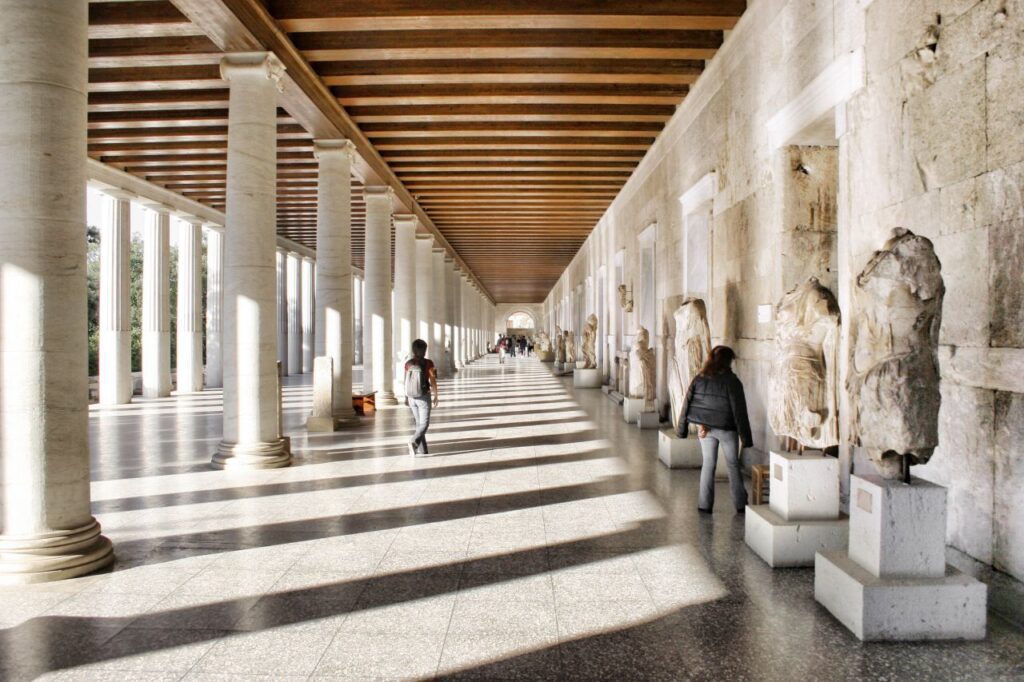
One of the monuments in the Agora, the Stoa of Attalos, was totally reconstructed in the 1950s. This covered walkway was first built by Attalos II in the mid-2nd century BC but was wrecked by the Herules in 267. The new building was as faithful as possible to the archaeological knowledge of the day and hosts the Museum of the Ancient Agora, showing off the artefacts brought to light during excavations in the area by the American School of Classical Studies. Awaiting you are Neolithic, Bronze Age, Iron Age and Geometric period figurines, weapons and vases recovered from tombs and wells.You can also see some thrilling pieces relating to Athenian democracy in the Classical and Late Classical periods, like an official bronze weight, shards of pottery used in ostracism ballots (ostracons), clay measuring devices, bronze and lead ballot disks once used in trials.
Panathenaic Stadium
Erected for the 1896 Olympics, the Panathenaic Stadium is a modern reconstruction of an ancient stadium built for the Panathenaic Games in 330 BC. Two hundred years later that ancient monument would be rendered in marble by the Athenian Roman senator Herodes Atticus. With a U-shape layout, the Panethenaic Stadium is an almost exact replica of the construction from the 2nd century BC, and like its ancient ancestor is composed completely from marble. It was seen around the world during the 2004 Athens Olympics when it staged the archery events and was the finish line for both the men’s and women’s marathon. The stadium can hold 45,000 spectators and from its highest tiers you can see the Acropolis and the National Garden.

The ultimate Athens City Breaks itinerary
- Day 1 : Morning , see the Panathenaic Stadium, home to the first Olympic Games of the modern era, the Temple of Olympian Zeus, Hadrian’s Arch, the Parliament and memorial to the Unknown Soldier, the Academy of Athens, the University, the National Library and the Constitution Square (SyntagmaDiscover Acropolis from the Propylaea, to the Temple of Athena Nike, the Erechtheion and of course the Parthenon, a place where ‘there is harmony between material and spirit’, a the monument that ‘restores order in the mind’, as ancient Greeks used to say. Conclude your visit with the modern Acropolis Museum, with nearly 4,000 exhibits of Hellenism housed inside. Book this excursion now. After noon Slink off for coffee and a cake at Zonar’s near Syntagma square. Established in 1937, it’s the most historic teahouse in Athens, on whose tables political deals and artistic alliances are still being struck. Dine in style at Galaxy restaurant on the roof of the Hilton hotel. Let your hair down afterwards at the rooftop bar-club where a DJ plays through to 4am.
- Day 2: Explore the closest islands to Athens with a full days cruise to Saronic islands. Visit Hydra, Poros and Aegina. Book this excursion now
- Day 3: Morning explore Plaka. Fortify yourself at Fresko Yogurt Bar. Try spoon sweets – sugary, preserved whole fruits like cherry, quince or plum – in the traditional way with a glass of iced water or over Greek yoghurt. Ride the cable car to the top of Lycabettus Hill – it operates until 2.30am – for a romantic dinner at Horizons restaurant (reservations advised). The panoramic views of the glistening city lights below are incredible.
Dou you want to book a 4-day Athens City-break ?
Related Readings
Athens Riviera Holidays , Best Day Trips From Athens , Nightlife in Athens, Islands Close to Athens, Greece Family Tours , Greece City Breaks, Greece Escorted Tours , Athens Walking Tours, Popular Cafes in Athens,










